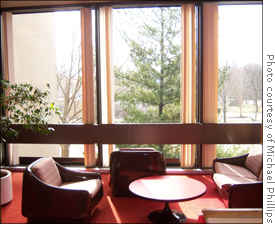
| << Front page | News | February 29, 2008 |
Central Heating Plant, Inefficient Buildings Come Under Scrutiny of Outside Energy Study
 |
|
| Lights On, Nobody Home: Oberlin’s energy audit cited locations such as this King hallway, lit by both sun and electricity, as sources of waste. | |
Some of the 4 million dollar donation from an anonymous Cleveland family for College environmental projects has recently been put to use. This past week, Oberlin’s Committee on Environmental Sustainability and the Facilities Planning and Construction Office kicked off an Energy Study for Campus Climate Neutral Plan with the firm Energy Ventures International. After about six months of assessing Oberlin’s buildings for energy efficiency, the company will make specific recommendations as to how to save money and reduce Oberlin’s carbon footprint.
The study will focus on the three main areas of Oberlin’s CO2 emissions: the coal-fired Central Heating Plant pumping away behind Mudd Library, the inefficient use of heat and electricity in campus buildings and the energy spent to bring electric power to the campus.
Michael Phillips, who leads the group conducting the study, explained his process in surveying Oberlin: “We’re working with Oberlin facilities staff and others to identify which buildings make the most sense to focus on — the buildings that use the most energy. These might be Mudd Center, the Science Center, the Conservatory and the Philips Center, but will most likely include some dorms as well.”
Once the group has chosen between six to eight buildings, they will begin a detailed examination of their energy usage and then recommend improvements to make them more energy efficient in lighting, heating, ventilation and air-conditioning. Finally, although they cannot conduct detailed energy assessments of all campus buildings, they plan to provide the College with ballpark estimates of what kinds of savings it could achieve if it pursued energy-efficient improvements in all buildings.
Many focus on the College’s coal plant as the most obvious area for improvement, as it is responsible for 30 percent of carbon emissions on campus. “In my opinion, we need to stop burning coal in the Central Heating Plant,” said student CES member and College senior Lora DiFranco. “A lot of students don’t even realize that we burn coal on this campus.”
Chair of the CES and professor of environmental studies John Petersen agrees. “Oberlin’s CHP burns coal, which has been an abundant and inexpensive source of energy, but is the most polluting of fossil fuels,” he said. “Oberlin needs to find a way to move away from coal as a heating fuel towards lower carbon intensity fuels.”
The CES worries equally about carbon emissions off-campus, specifically the CO2 emitted to deliver electricity to the College. Under the current green electricity purchasing agreement with the Oberlin Municipal Light and Power, Oberlin purchases approximately half of the College’s electricity from green energy sources, all of the green electricity that OMLPS has available. To allow Oberlin to reach 100 percent green energy sources, OMLPS would have to purchase or develop other sources of green energy.
Some wonder if Oberlin will have any money left after this expensive survey to implement the firm’s ideas. “A lot of the suggestions will end up saving the college money in the long run, so we hope that the administration will be motivated by that [to give funds],” said DiFranco. “There are also alumni that are interested in helping out Oberlin complete green renovations.”
Petersen feels that fundraising can only start after the survey’s conclusive results are in. “We can’t easily raise the money to make Oberlin climate neutral without good solid figures on costs,” he said. “Having a good study in no way guarantees that we will have funds to implement recommendations, but we can’t very well raise funds without the study. With that said, once we have defined goals, priorities and cost estimates, I think that Marvin Krislov and others in the administration are committed to finding funds.”
Those involved in this project cite the American College and University Presidents’ Climate Commitment that Oberlin signed in the fall of 2006, which committed the College to achieving carbon neutrality, as the major motivation behind this study—especially the student drive that made it happen. “We would never have signed the ACUPCC without student activists,” said Petersen. “Sometimes you don’t realize what an important role [students] play, but we would never be hiring this firm if were not for the very hard work of Oberlin students.”
Petersen also stressed that change is possible not just on the institutional level, but in day-to-day life. “Every student and every employee of the College has a critical role to play in terms of their personal action. All those computers and lights left on. All those windows left open in the winter. Those are all changing the climate. Conversely, all those lights and computers turned off and windows kept closed are critical to achieving the goal of climate neutrality.”
About us
Subscriptions
Advertising